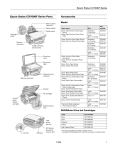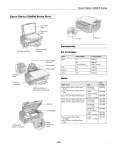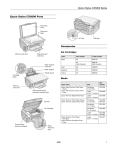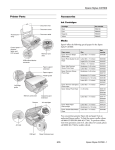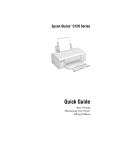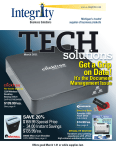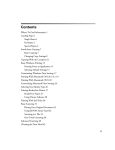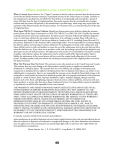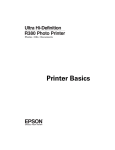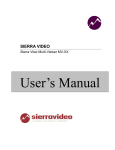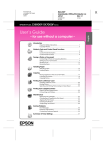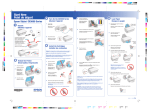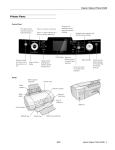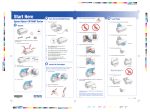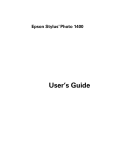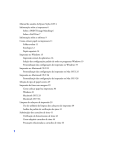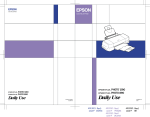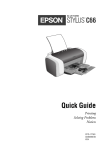Download Epson CX7000F Basic Guide
Transcript
Epson Stylus ® CX7000F Series Basics Guide Copyright Notice All rights reserved. No part of this publication may be reproduced, stored in a retrieval system, or transmitted in any form or by any means, electronic, mechanical, photocopying, recording, or otherwise, without the prior written permission of Seiko Epson Corporation. The information contained herein is designed only for use with this Epson product. Epson is not responsible for any use of this information as applied to other equipment. Neither Seiko Epson Corporation nor its affiliates shall be liable to the purchaser of this product or third parties for damages, losses, costs, or expenses incurred by purchaser or third parties as a result of: accident, misuse, or abuse of this product or unauthorized modifications, repairs, or alterations to this product, or (excluding the U.S.) failure to strictly comply with Seiko Epson Corporation’s operating and maintenance instructions. Seiko Epson Corporation shall not be liable for any damages or problems arising from the use of any options or any consumable products other than those designated as Original Epson Products or Epson Approved Products by Seiko Epson Corporation. Responsible Use of Copyrighted Materials Epson encourages each user to be responsible and respectful of the copyright laws when using any Epson product. While some countries’ laws permit limited copying or reuse of copyrighted material in certain circumstances, those circumstances may not be as broad as some people assume. Contact your legal advisor for any questions regarding copyright law. Trademarks Epson and Epson Stylus are registered trademarks, and Exceed Your Vision, USB DIRECT-PRINT, and the USB DIRECT-PRINT logo are trademarks of Seiko Epson Corporation. DURABrite is a registered trademark and Epson Connection is a service mark of Epson America, Inc. DPOF is a trademark of CANON INC., Eastman Kodak Company, Fuji Photo Film Co., Ltd. and Matsushita Electric Industrial Co., Ltd. Memory Stick is a registered trademark, and Memory Stick Duo, Memory Stick PRO, Memory Stick PRO Duo, MagicGate, MagicGate Memory Stick, and MagicGate Memory Stick Duo are trademarks of Sony Corporation. xD-Picture Card is a trademark of Fuji Photo Film Co., Ltd. SmartMedia is a registered trademark of Toshiba Corporation. SD is a trademark. SDHC is a trademark. General Notice: Other product names used herein are for identification purposes only and may be trademarks of their respective owners. Epson disclaims any and all rights in those marks. © 2007 Epson America, Inc. 1/07 2 Contents Loading Paper . . . . . . . . . . . . . . . . . . . . . . . . . . . . . . . . . . . . . . . . . 6 Copying a Photo or Document . . . . . . . . . . . . . . . . . . . . . . . . . . 8 Placing the Original on the Glass . . . . . . . . . . . . . . . . . . . . . . . . . . . . . . . 8 Copying . . . . . . . . . . . . . . . . . . . . . . . . . . . . . . . . . . . . . . . . . . . . . . . . 9 Printing From a Memory Card . . . . . . . . . . . . . . . . . . . . . . . . . . Compatible Cards and Image Formats . . . . . . . . . . . . . . . . . . . . . . . . . . Inserting the Card . . . . . . . . . . . . . . . . . . . . . . . . . . . . . . . . . . . . . . . . Printing an Index Sheet to Select Photos . . . . . . . . . . . . . . . . . . . . . . . . . Printing All Photos or DPOF Photos . . . . . . . . . . . . . . . . . . . . . . . . . . . 12 13 14 15 18 Printing From a Digital Camera . . . . . . . . . . . . . . . . . . . . . . . . . 19 Printing From Your Computer . . . . . . . . . . . . . . . . . . . . . . . . . . Printing in Windows . . . . . . . . . . . . . . . . . . . . . . . . . . . . . . . . . . . . . . Printing With a Macintosh . . . . . . . . . . . . . . . . . . . . . . . . . . . . . . . . . . Using Special Papers . . . . . . . . . . . . . . . . . . . . . . . . . . . . . . . . . . . . . . . 20 20 23 26 Faxing a Photo or Document . . . . . . . . . . . . . . . . . . . . . . . . . . . 29 Connecting a Phone or Answering Machine . . . . . . . . . . . . . . . . . . . . . . . Setting Up Your Fax Features . . . . . . . . . . . . . . . . . . . . . . . . . . . . . . . . . Sending a Fax . . . . . . . . . . . . . . . . . . . . . . . . . . . . . . . . . . . . . . . . . . . Receiving a Fax . . . . . . . . . . . . . . . . . . . . . . . . . . . . . . . . . . . . . . . . . . 29 30 37 39 Scanning a Photo or Document . . . . . . . . . . . . . . . . . . . . . . . . 41 Basic Scanning . . . . . . . . . . . . . . . . . . . . . . . . . . . . . . . . . . . . . . . . . . . 41 Restoring Color in Faded Photos . . . . . . . . . . . . . . . . . . . . . . . . . . . . . . 43 Maintaining Your CX7000F Series . . . . . . . . . . . . . . . . . . . . . . 44 Checking the Print Head Nozzles . . . . . . . . . . . . . . . . . . . . . . . . . . . . . . 44 Cleaning the Print Head . . . . . . . . . . . . . . . . . . . . . . . . . . . . . . . . . . . . 45 3 Checking the Ink Status . . . . . . . . . . . . . . . . . . . . . . . . . . . . . . . . . . . . 46 Replacing Ink Cartridges . . . . . . . . . . . . . . . . . . . . . . . . . . . . . . . . . . . . 47 Solving Problems . . . . . . . . . . . . . . . . . . . . . . . . . . . . . . . . . . . . . 52 Error Messages . . . . . . . . . . . . . . . . . . . . . . . . . . . . . . . . . . . . . . . . . . . 52 Problems and Solutions . . . . . . . . . . . . . . . . . . . . . . . . . . . . . . . . . . . . . 54 Where To Get Help . . . . . . . . . . . . . . . . . . . . . . . . . . . . . . . . . . . . . . . 57 Notices. . . . . . . . . . . . . . . . . . . . . . . . . . . . . . . . . . . . . . . . . . . . . . . 59 Important Safety Instructions . . . . . . . . . . . . . . . . . . . . . . . . . . . . . . . . . Declaration of Conformity . . . . . . . . . . . . . . . . . . . . . . . . . . . . . . . . . . FCC Compliance Statement . . . . . . . . . . . . . . . . . . . . . . . . . . . . . . . . . Epson America, Inc. Limited Warranty . . . . . . . . . . . . . . . . . . . . . . . . . . 59 61 61 64 Index . . . . . . . . . . . . . . . . . . . . . . . . . . . . . . . . . . . . . . . . . . . . . . . . 67 4 Contents Introduction After you have set up your Epson Stylus® CX7000F Series all-in-one as described on the Start Here sheet, turn here to: ■ Load paper ■ Make a quick copy of a photo or document ■ Print photos stored on a memory card ■ Print photos directly from your camera ■ Print a basic document or photo from your computer ■ Fax a photo or document ■ Scan a photo or document, including restoring a color photo as you scan ■ Perform routine maintenance ■ Solve simple problems This book tells you how to do most of these things without ever turning on your computer! Of course your CX7000F Series can do a lot more when you connect it to your Windows® or Macintosh® computer. For additional instructions, see the on-screen User’s Guide by selecting the icon for it on your desktop. Please follow these guidelines as you read your CX7000F Series instructions: Warning: Warnings must be followed carefully to avoid bodily injury. Caution: Cautions must be observed to avoid damage to your equipment. Note: Notes contain important information about your CX7000F Series. Tip: Tips contain hints for better copying, scanning, printing, and faxing. 5 Loading Paper Follow the steps here to load paper in your Epson Stylus CX7000F Series all-in-one. 1. Open the paper support and slide out the extensions. 2. Open the output tray and pull out the extension. 3. Flip the feeder guard forward. 6 Loading Paper 4. Insert the paper, printable side up, against the right edge guide and beneath the tabs. (The printed side is whiter or brighter on some papers.) Always load paper short edge first, even for landscape printing. Place paper beneath the tabs You can load up to 100 sheets of plain paper and up to 20 sheets of photo paper (see the User’s Guide for capacity guidelines on other paper types). Note: The type of paper you choose affects the way your printout looks, so be sure to select the correct paper for your job. If you are just making a copy or printing a rough draft of an image, plain paper is fine. However, for the best results, you’ll want to use one of Epson’s special ink jet papers designed for your printer. For example, your photos will look great printed on Epson Ultra Premium Photo Paper Glossy (see page 26 for more information). 5. Slide the left edge guide against the left edge of the paper (but not too tightly). 6. Flip the feeder guard back. Loading Paper 7 Copying a Photo or Document Follow the instructions in this section to: ■ Position your photo or document correctly on the glass (see below) ■ Make copies of a photo or document (see page 9) Placing the Original on the Glass 1. Open the document cover and place your original face-down on the glass, in the upper left corner. 2. Close the cover gently so you don’t move the original. Caution: Never open the document cover beyond where it stops and do not place heavy objects on top of the Epson Stylus CX7000F Series all-in-one. 8 Copying a Photo or Document If you need to copy or scan a thick or large document, you can remove the document cover. Just open it and pull it straight up. If you need to press the document flat while you copy or scan it, do not press too hard and be careful not to move it. Note: Do not use excessive force on the document cover and do not twist it. You may damage the document cover. When you are done, replace the document cover by inserting the tabs back into the slots. Copying You can make copies using letter-size (8.5 × 11-inch), 4 × 6-inch, or 5 × 7-inch plain or photo paper. Copying a Document 1. Press the P On button to turn on the CX7000F Series. You see a screen like this: 12:00 PM Y 2. Place the document on the glass as described on page 8. Be sure to close the document cover. 3. Load up to 100 sheets of letter-size plain paper. See page 6 for details. Copying 9 4. Press the Copy button. You see this display: 5. If you want your copies automatically reduced or enlarged to fit the loaded paper size (Fit to Page mode), press the Copy button again. The display changes to this: Copies:1 100% Copies:1 FitPage 6. To make multiple copies (up to 99), press the number keys on the numeric keypad. The display shows the number you select. Note: To exit Copy mode, press the y Cancel/Back button. 7. Press the paper type button to select Plain Paper. The light indicates which type is selected. 8. Press the paper size button to select Letter. 9. To make a color copy, press the x Start Color/OK button. To make a black and white copy, press the x Start B&W button. Printing appears on the display and the CX7000F Series starts copying. If you need to stop copying, press the y Cancel/Back button. Do not pull out paper that is being printed; it will be ejected automatically to the output tray. Note: The copies may not be exactly the same size as the original. Copying a Photo 1. Press the P On button to turn on the CX7000F Series. You see a screen like this: 12:00 PM Y 2. Place the photo on the glass as described on page 8. Be sure to close the document cover. 3. Load up to 20 sheets of letter-size, 4 × 6-inch, or 5 × 7-inch photo paper. See page 7 for details. 4. Press the Copy button. You see this display: 5. If you want borderless photos (printed without a white border), press the Copy button again to select Fit to Page mode. (If you select 100%, photos are printed with a border.) The display changes to this: 10 Copying a Photo or Document Copies:1 100% Copies:1 FitPage 6. To make multiple copies (up to 99), press the number keys on the numeric keypad. The display shows the number you select. Note: To exit Copy mode, press the y Cancel/Back button. 7. Press the paper type button to select Photo Paper. 8. Press the paper size button to select Letter, 4"× 6", or 5"× 7". 9. To make a color copy, press the x Start Color/OK button. To make a black and white copy, press the x Start B&W button. Printing appears on the display and the CX7000F Series starts copying. If you need to stop copying, just press the y Cancel/Back button. Do not pull out paper that is being printed; it will be ejected automatically to the output tray. Note: The copies may not be exactly the same size as the original. When making a lot of copies, it is a good idea to remove the printed copies from the output tray after every 10 sheets or so. Making a Quick Copy If you want to make a copy quickly and do not need high quality, you can print a “draft” copy. The print quality is reduced, but the copy is printed faster. 1. Load plain, letter-size paper and select Plain Paper and Letter size on the control panel. 2. Press the Copy button. If you want your copies automatically reduced or enlarged to fit the loaded paper size, press the Copy button again to select Fit to Page mode. 3. When you are ready to copy, press and hold the y Cancel/Back button, then press and hold the x Start Color/OK button (to copy in color). When you see Color Draft Mode on the display, release both buttons. Printing appears on the display. To make a black and white copy, press and hold the y Cancel/Back button, then press and hold the x Start B&W button. When you see B/W Draft Mode on the display, release both buttons. Printing appears on the display. Copying 11 Printing From a Memory Card The Epson Stylus CX7000F Series all-in-one lets you print color photos directly from your digital camera’s memory card; just insert it into a memory card slot on the CX7000F Series and you’re ready to print. If your digital camera supports DPOF™ (Digital Print Order Format), you can pre-select the photos you want to print while the card is still in the camera. Then, when you insert the card in the CX7000F Series, it knows which photos to print and how many copies of each. See these sections: ■ “Compatible Cards and Image Formats” on page 13 ■ “Inserting the Card” on page 14 ■ “Printing an Index Sheet to Select Photos” on page 15 ■ “Printing All Photos or DPOF Photos” on page 18 For instructions on copying memory card files between your CX7000F Series and a computer or other device, see the User’s Guide. 12 Printing From a Memory Card Compatible Cards and Image Formats You can use the following types of cards with your CX7000F Series: Right slot Slot Type of card Right slot CompactFlash® Microdrive™ Left slot SD™ SDHC™ miniSD™* miniSDHC* microSD* microSDHC* MultiMediaCard™ Memory Stick™ Memory Stick Duo™* Memory Stick PRO™ Memory Stick PRO Duo™* MagicGate™ Memory Stick MagicGate Memory Stick Duo™* SmartMedia™ xD-Picture Card™ xD-Picture Card Type H xD-Picture Card Type M Memory card access light Left slot The CX7000F Series supports image files that meet the following requirements: Media format DCF version 1.0 or 2.0 compliant* File format JPEG Supports Exif version 2.21 Image size 80 × 80 pixels to 9200 × 9200 pixels Number of files Up to 999 * DCF is the “Design rule for Camera File system” standard Note: You can print only in color when printing directly from a memory card; you cannot print in black and white. Compatible Cards and Image Formats 13 Inserting the Card 1. Make sure the CX7000F Series is turned on. 2. Open the memory card door. 3. Make sure the memory card access light is off and that no cards are in any of the slots. Then insert your card into the correct slot (see page 13 for details). The memory card access light flashes and then stays on. Left slot Insert just one card at a time Right slot Memory card access light 4. Now you can: ■ Print an index sheet so you can select which photos to print (see page 15) ■ Print all the photos on the card (see page 18) ■ Print photos pre-selected on your camera using DPOF (see page 18) When you want to remove the card, make sure the memory card access light is not flashing, then pull the card straight out of its slot. Caution: Do not remove the card or turn off the CX7000F Series while the memory card access light is flashing; you may lose data on the card. 14 Printing From a Memory Card Printing an Index Sheet to Select Photos You can print an index sheet (which is like a photographer’s contact or proof sheet) to see small “thumbnail” images of all the pictures on your card. Then you can mark the pictures on the index sheet that you want to print, scan the sheet, and let the CX7000F Series automatically print the selected photos. Printing the Index Sheet 1. Make sure your CX7000F Series is not connected to your computer (or your computer is turned off ). 2. Load several sheets of letter-size, plain paper. (Use only letter-size paper to print the index sheet.) Up to 30 images are printed on each page, so if there are more than 30 photos on the memory card, you’ll need enough sheets for all the index pages to be printed. 3. Insert the memory card if it is not already in the slot. See page 14 for details. 4. If the light in the Memory Card button is not lit, press the Memory Card button. The CX7000F Series counts the images on your card and you see this display, indicating it is ready to print the index sheet: Number of images (varies) 1.Img:92 Prt Idx 5. Make sure Plain Paper and Letter are selected. 6. Press the x Start Color/OK button. You see this display 1.Prt Idx: File Printing an Index Sheet to Select Photos 15 7. Press the x Start Color/OK button again. The CX7000F Series starts printing the index sheet(s). This may take a few minutes. For multiple index sheets, the pages containing the most recent images are printed first. If you want to cancel printing more sheets, press the y Cancel/Back button. Now follow the instructions below to select which photos to print. Selecting Photos on the Index Sheet 1. Once you have printed the index sheet, use a dark pen or pencil to fill in one of the ovals beneath each photo you want to print to indicate how many copies you want (1, 2, or 3). OK: Incorrect: Make sure just one oval is filled in for each selected photo and mark the sheet carefully; once it has been scanned you will not be able to change your selections. Tip: If you want one copy of all the photos on the index sheet, fill in the ALL oval at the top of the page. 16 Printing From a Memory Card 2. Place the index sheet face-down on the glass, in the upper left corner, so that the top of the sheet is aligned against the left edge of the glass. 3. Close the document cover. Note: Don’t remove the memory card while you’re printing from an index sheet. 4. Load up to 100 sheets of plain paper or up to 20 sheets of photo paper at a time. (See page 7 for details.) You can load more paper later as necessary to print all your selected photos. The display should now look like this, indicating that the CX7000F Series is ready to scan the index sheet: 2.Img:92 Scn Idx If this setting is not displayed, press the Memory Card button until it is displayed. 5. Select Plain Paper or Photo Paper (whichever you loaded). If you select Plain Paper, the photos print with a white border. If you select Photo Paper, the photos print borderless, to the edge of the paper. 6. Select Letter, 4"x 6", or 5"x 7" for the paper size. 7. Press the x Start Color/OK button to start printing. Note: If you need to stop printing, press the y Cancel/Back button. 8. When you are done printing, wait until the memory card access light is not flashing, then remove the memory card by pulling it straight out of its slot. Printing an Index Sheet to Select Photos 17 Printing All Photos or DPOF Photos Follow the steps below to print one copy of each photo on the card or to print only those photos that were pre-selected with your camera’s DPOF (Digital Print Order Format) feature. 1. Load up to 100 sheets of plain paper or up to 20 sheets of photo paper at a time. (See page 7 for details.) You can load more paper later as necessary to print all your photos. 2. Insert the memory card. See page 14 for details. 3. Press the Memory Card button repeatedly, until the display looks something like this. 3.Img:92 All/DPO Note: If the memory card does not contain DPOF information, one copy of all the photos on the card will be printed. 4. Select Plain Paper or Photo Paper (whichever you loaded). If you select Plain Paper, the photos print with a white border. If you select Photo Paper, the photos print borderless, to the edge of the paper. 5. Select Letter, 4"× 6", or 5"× 7" for the paper size. 6. Press the x Start Color/OK button to start printing. Note: If you need to stop printing, press the y Cancel/Back button. If you see the Paper Out message, load more paper and press the x Start Color/OK button. When you are done printing, wait until the memory card access light is not flashing, then remove the memory card by pulling it straight out of its slot. 18 Printing From a Memory Card Printing From a Digital Camera If your camera is PictBridge- or USB DIRECT-PRINT™-compatible, you can print your JPEG photos by connecting your digital camera directly to your Epson Stylus CX7000F Series all-in-one. Your photos must be sized from 80 × 80 pixels to 9200 × 9200 pixels. 1. Make sure your CX7000F Series is turned on, but not printing. 2. Remove any memory cards from the slots. 3. Load the type of paper you want to use (see page 6). Load enough sheets for the number of photos you’ll be printing. 4. Press the paper type button to select Photo Paper to print borderless photos (without a white border). Select Plain Paper if you want your photos printed with a small white border. 5. Press the paper size button to select Letter, 4"x6", or 5"x7". 6. Connect the USB cable that came with your camera to the camera and to the USB connector on the front of your CX7000F Series. 7. Make sure your camera is turned on. The following appears on the display screen: PictBridge 8. Select the photos you want to print with your camera. Then adjust any necessary settings and print your photos as explained in your camera manual. Note: Depending on the CX7000F Series settings and your digital camera settings, some combinations of paper type, size, and layout may not be supported. In addition, some of your digital camera settings may not be reflected in the printed output. Epson cannot guarantee the compatibility of any camera. Printing From a Digital Camera 19 Printing From Your Computer This section describes the basic steps for printing a photo or document stored on your Windows or Macintosh computer. Note: For detailed instructions on printing, see the on-screen User’s Guide. Before you start, make sure you’ve installed your printer software and connected the Epson Stylus CX7000F Series all-in-one to your computer as described on the Start Here sheet. Also be sure to use the right paper for your print job (see page 26) and select the correct paper type setting for it in the steps below. Tip: Periodically, it’s a good idea to check Epson’s support website at epson.com/support for free updates to your CX7000F Series printer and scanner software. Download instructions are posted for your convenience. With Windows, you can also click Start or , select Programs or All Programs, select EPSON, and click EPSON Stylus CX7000F Series Driver Update for driver updates. Follow the instructions in these sections: ■ “Printing in Windows” (below) ■ “Printing With a Macintosh” on page 23 ■ “Using Special Papers” on page 26 Printing in Windows 1. Load paper (see page 6). 2. Open a photo or document in a printing program. 20 Printing From Your Computer 3. Open the File menu and select Print. You see a window like this one: Select EPSON Stylus CX7000F Series 4. Make sure EPSON Stylus CX7000F Series is selected, then click the Preferences or Properties button. (If you see a Setup, Printer, or Options button, click it. Then click Preferences or Properties on the next screen.) 5. On the Main tab, select the basic print settings: w Select the type of document you’re printing (choose Photo or Best Photo for pictures) Select your paper Type Click here for borderless photos Select your paper Size Select your document Orientation Click here for more options Printing in Windows 21 Make sure you choose the correct paper Type setting for the paper you are using (see page 28 for details). Note: For more information about print settings, click the ? or Help button. 6. For more printing options, click the Advanced button. Then select the following settings as necessary: Select a color management method (To choose No Color Adjustment, click ICM first) Select Paper & Quality Options as necessary Select Print Options as necessary Click here if you want to see this Advanced screen each time you access your print settings Note: For more information about advanced settings, or instructions on saving them as a group so you can reuse them later, click ? or Help. 7. If you want to change the layout settings, click the Page Layout tab and select settings as necessary. 22 Printing From Your Computer 8. Click OK to save your settings, then click OK or Print to start printing. This window appears and shows the progress of your print job. w Check ink cartridge status Pause or resume printing Cancel printing Printing With a Macintosh 1. Load paper (see page 6). 2. Open the photo or document in a printing program. 3. Select Page Setup from the File menu. Make the following settings: Select Stylus CX7000F Select your Paper Size Select your document or image orientation For borderless printing, choose a Sheet Feeder - Borderless option in the Paper Size list for your paper size (US Letter, 8 x 10 in, 4 x 6 in, or 5 x 7 in). 4. Click OK to close the Page Setup window. Printing With a Macintosh 23 5. Select Print from the File menu. You see a window like this one: Select Stylus CX7000F Select Print Settings 6. Choose Print Settings from the pop-up menu and select the following settings as necessary: Select your Media Type (see page 26) Select Color or Black ink Select higher quality or faster printing Select Automatic mode Note: In certain programs, you may need to select Advanced before you can select Print Settings. For more information about printer settings, click the ? button. 7. Depending on your settings, you can choose other options from the pop-up menu including: ■ Copies & Pages: Select the number of copies you want, or a page range. ■ Layout: Select page layout options. ■ Output Options: Save your print job as a PDF file (OS X 10.2.x or 10.3.x). In OS X 10.4.x, click the PDF button instead. ■ Scheduler: Schedule your print job to print at a later time. 24 Printing From Your Computer ■ Paper Handling: Select page printing options, such as Reverse print order. ■ ColorSync or Color Management: Select ColorSync® or adjust the color controls, change the gamma setting, or turn off color adjustments in the printer software. ■ Cover Page (OS X 10.4.x only): Add a cover page before or after the document. ■ Expansion: Reduce or enlarge the image size for borderless printing. ■ Summary: View a list of all your selections. 8. Click the Advanced button to change additional settings. Select Print Quality and other options as necessary Note: For more information on advanced settings, or instructions on saving them as a group so you can reuse them later, click ?. 9. Click Print. 10. To monitor the progress of your print job, click the appears in the dock on the bottom of your desktop. printer icon when it If you’re using OS X 10.2.x, click the Print Center icon instead, then double-click Stylus CX7000F in the Printer List window. Printing With a Macintosh 25 You see a screen like this: Pause printing Resume printing Cancel printing Select the print job 11. When you’re finished, close the printer window or Print Center. Using Special Papers Epson offers a wide array of high quality papers, making it easy to maximize the impact of your photos, presentations, and creative projects. Paper category Description Photo Papers For lab quality photos—from everyday snapshots to professional portraits. Available in glossy, semi-gloss, and luster finishes. Matte Papers Non-glare paper with a smooth or textured finish for professional quality photos, brochures, or art projects. Scrapbooking Papers Acid-free, lignin-free paper for archival quality photos, backgrounds, headlines, and other page elements. Fine Art Papers Luxurious weight, texture, and finish give these fine art papers a true museum quality appearance. Specialty Papers For projects that showcase your favorite photos, including greeting cards, iron-on transfers, and transparencies. You can purchase genuine Epson ink and paper online at www.epsonstore.com (U.S. sales) or www.epson.ca (Canadian sales). You can also purchase them from an Epson authorized reseller. To find the nearest reseller, call 800-GO-EPSON (800-463-7766). 26 Printing From Your Computer Paper name Size Part number Epson Ultra Premium Photo Paper Glossy Epson Ultra Premium Glossy Photo Paper Borderless 4 × 6 inches S041934 Letter (8.5 × 11 inches) S041935 Epson Premium Photo Paper Glossy Epson Premium Glossy Photo Paper Borderless 4 × 6 inches S041808 S041727 Borderless 5 × 7 inches S041464 Borderless 8 × 10 inches S041465 Letter (8.5 × 11 inches) S041286 S041667 Epson Premium Photo Paper Semi-gloss Epson Premium Semigloss Photo Paper Letter (8.5 × 11 inches) S041331 Epson Photo Paper Glossy Epson Glossy Photo Paper 4 × 6 inches S041134 S041671 S041458 S041809 Letter (8.5 × 11 inches) S041141 S041649 S041271 Epson Bright White Paper Epson Premium Bright White Paper Letter (8.5 × 11 inches) S041586 Epson Premium Presentation Paper Matte Epson Matte Paper Heavyweight Letter (8.5 × 11 inches) S041257 Borderless 8 × 10 inches S041467 Epson Premium Presentation Paper Matte Double-sided Epson Double-Sided Matte Paper Letter (8.5 × 11 inches) S041568 Epson Presentation Paper Matte Epson Photo Quality Ink Jet Paper Letter (8.5 × 11 inches) S041062 Legal (8.5 × 14 inches) S041067 A4 (8.3 × 11.7 inches) S041061 Epson Photo Quality Self-Adhesive Sheets A4 (8.3 × 11.7 inches) S041106 Epson Iron-On Cool Peel Transfer Paper Epson Iron-On Transfer Paper Letter (8.5 × 11 inches) S041153 Using Special Papers 27 Paper name Size Part number PremierArt Matte Scrapbook Photo Paper for Epson Letter (8.5 × 11 inches) SCR1002 Select the correct Type (see page 21) or Media Type (see page 24) setting for your paper in your printer software. For this paper . . . Select this Type or Media Type setting . . . Plain paper Plain Paper/Bright White Paper Epson Bright White Paper Epson Premium Bright White Paper Epson Ultra Premium Photo Paper Glossy Ultra Premium Photo Paper Glossy Epson Ultra Premium Glossy Photo Paper Epson Premium Photo Paper Glossy Premium Photo Paper Glossy Epson Premium Glossy Photo Paper Epson Photo Paper Glossy Photo Paper Glossy Epson Glossy Photo Paper Epson Premium Photo Paper Semi-gloss Premium Photo Paper Semi-Gloss Epson Premium Semigloss Photo Paper Epson Premium Presentation Paper Matte Premium Presentation Paper Matte Epson Matte Paper Heavyweight Epson Premium Presentation Paper Matte Double-sided Epson Double-sided Matte Paper Epson Presentation Paper Matte Epson Photo Quality Ink Jet Paper Epson Photo Quality Self-Adhesive Sheets Epson Iron-On Cool Peel Transfer Paper Epson Iron-On Transfer Paper PremierArt Matte Scrapbook Photo Paper for Epson Envelopes 28 Printing From Your Computer Envelope Faxing a Photo or Document Your Epson Stylus CX7000F Series all-in-one lets you send faxes by entering fax numbers or selecting entries from a speed dial list. You can customize the fax header information, and select various report printing and send/receive settings. You can also set up your CX7000F Series to automatically receive faxes or select to receive them only when you’ve confirmed that you’re receiving a fax. See these sections: ■ “Connecting a Phone or Answering Machine” below ■ “Setting Up Your Fax Features” on page 30 ■ “Sending a Fax” on page 37 ■ “Receiving a Fax” on page 39 For more information on faxing and selecting fax settings, see the User’s Guide. Connecting a Phone or Answering Machine If you’re connecting the CX7000F Series to a phone line, and connecting a telephone or answering machine to the same phone line so you can use it to make voice calls, follow these steps: 1. Connect the phone cable leading from the wall jack to the LINE port. 2. Connect one end of another phone cable to the telephone or answering machine. 3. Connect the other end of the phone/answering machine cable to the EXT port on the back of the CX7000F Series. Faxing a Photo or Document 29 You also need to set up your CX7000F Series to receive faxes manually. See page 39 for details. Setting Up Your Fax Features Before sending or receiving faxes, you may want to create a fax header, select your fax preferences, and set up a speed dial list of frequently used fax numbers. Creating Header Information 1. Press the Fax button once to enter Fax mode. The Fax button lights up and you see this display: Enter Fax Number 2. Press the Setup button. You see this display: 1.Select Speed D 3. Press the u or d button, or press the 6 key on the numeric keypad, to display this option: 6.Header & Time 4. Press the x Start Color/OK button. You see this display: 1.Fax Header Set 5. Press the x Start Color/OK button again. The display goes blank except for the cursor (_). 6. Press the keys on the numeric keypad to enter up to 28 digits of header information. Use the number keys to enter the letters A to Z (in uppercase or lowercase), the numbers 0 to 9, and various symbols. Press a key repeatedly to display first the numbers and symbols (if available), then the uppercase and lowercase letters, as indicated on the key. Then wait a moment or press the r button to move to the next character space. When you’re finished, press the r button to move to a blank space. Note: If you need to change a character to the left, press the l key to delete the character and re-enter it. Press the r key if you need to move the cursor to the right. 7. Press the x Start Color/OK button. You return to the 1.Fax Header Setup display. 30 Faxing a Photo or Document 8. Press the u or d button, or press the 2 key on the numeric keypad, to display this option: 9. Press the x Start Color/OK button. You see this display (to indicate the two-digit month, day, and year): 2.Date/Time MM:DD:YY 10. Press the keys on the numeric keypad to enter the date. You can enter the numbers 0 to 9. 11. Press the x Start Color/OK button. You see this display (to indicate the hour and minute): HH:MM AM 12. Press the keys on the numeric keypad to enter the time in a 12-hour format. You can enter the numbers 0 to 9. 13. Press the x Start Color/OK button. You see this display: 1: AM 2: PM 14. Press the 1 key or the 2 key on the numeric keypad to select AM (1) or PM (2). 15. Press the x Start Color/OK button. You return to the 2.Date/Time display. 16. If you want to print your fax number in the fax header, press the u or d button, or press the 3 key on the numeric keypad, to display this option: 3.Your Phone Num 17. Press the x Start Color/OK button. The display goes blank except for the cursor (_). 18. Press the keys on the numeric keypad to enter your fax number. You can enter the numbers 0 to 9, and the characters * and #, up to 20 digits total. 19. Press the x Start Color/OK button. 20. Press the y Cancel/Back button until you return to the screen displaying the date. Selecting the Paper Size Before you receive a fax, be sure to load plain paper and set the Paper Size setting to the size of paper you’ve loaded. Also make sure the Automatic Reduction setting is set to receive faxes in the desired size. See the next section for details. Setting Up Your Fax Features 31 Selecting Send/Receive Settings Your CX7000F Series is set up to send and receive faxes using the default settings below. For more information about these and other fax settings, see the User’s Guide. Setting and Options Description Paper Size Letter (8.5 × 11; default) Legal (8.5 × 14) A4 (8.3 × 11.7) Indicates the size of the paper loaded in the CX7000F Series for printing received faxes. Automatic Reduction On (default) Off Indicates whether large received faxes are reduced in size to fit on the selected Paper Size or printed at their original size on multiple sheets. Last Transmission Report Off On Error (default) On Send Indicates whether or when the CX7000F Series prints a report for outgoing faxes. Select Off to turn off report printing, On Error to print reports only when an error occurs, or On Send to print reports for every fax you send. Dial Mode Tone (default) Pulse Indicates the type of phone system to which you’ve connected the CX7000F Series. DRD All (default) Single Double Triple Double & Triple Indicates the type of answer ring pattern you want to use to receive faxes. You must have set up your phone system to use different ring patterns to select an option other than All. ECM On (default) Off Indicates whether you use Error Correction Mode to automatically request retransmission of fax data that is received with detected errors. V.34 On (default) Off Indicates the speed at which you transmit faxes. On is 33.6 Kbps and Off 14.4 Kbps. Rings to Answer 5 (default) 1, 2, 3, 4, 5, 6, 7, 8, or 9 Indicates the number of rings that must occur before the CX7000F Series automatically receives a fax. 32 Faxing a Photo or Document To change the fax settings listed above, follow these steps: 1. Press the Fax button once to enter Fax mode. The Fax button lights up and you see this display: Enter Fax Number 2. Press the Setup button. You see this display: 1.Select Speed D 3. If you need to change the Paper Size, Automatic Reduction, or Last Transmission Report settings, press the u or d button, or press the 4 key on the numeric keypad, to display this option: 4. Press the x Start Color/OK button. You see this display: 4.Scan & Print S 1.Resolution 5. Press the u or d button, or press the 3, 4, or 5 key on the numeric keypad, to display one of these options: ■ 3.Paper Size ■ 4.Automatic Reduction ■ 5.Last Transmission Report Then press the x Start Color/OK button. 6. Press the u or d button until the setting option you want is displayed, then press the x Start Color/OK button to select it. 7. Repeat steps 5 and 6 to change any other settings. When you’re finished, press the y Cancel/Back button to return to the 4.Scan & Print Setup menu. 8. If you need to change the Dial Mode, DRD, ECM, V.34, or Rings to Answer settings, press the u or d button, or press the 5 key on the numeric keypad, to display this option: 9. Press the x Start Color/OK button. You see this display: 5.Communication 1.Dial Mode: Ton Setting Up Your Fax Features 33 10. To change the Dial Mode setting, press x Start Color/OK and go to step 11. To change another Communication setting, press the u or d button, or press the 2, 3, 4, or 5 key on the numeric keypad, to display one of these options: ■ 2.DRD ■ 3.ECM ■ 4.V.34 ■ 5.Rings to Answer Then press the x Start Color/OK button. 11. Press the u or d button until the setting option you want is displayed, then press the x Start Color/OK button to select it. 12. Repeat steps 10 and 11 to change any other settings. When you’re finished, press the y Cancel/Back button to return to the screen displaying the date. Setting Up Your Speed Dial List You can create a speed dial list of up to 60 fax numbers so you can quickly select them for faxing. You can also add names to identify the recipients and print the speed dial list. 1. Press the Fax button once to enter Fax mode. The Fax button lights up and you see this display: Enter Fax Number 2. Press the Setup button. You see this display: 1.Select Speed D 3. Press the u or d button, or press the 3 key on the numeric keypad, to display this option: 3.Speed Dial Set 4. Press the x Start Color/OK button. You see this display: 1.Add Entry 5. Press the x Start Color/OK button again. You see this display: [01] 6. Press the x Start Color/OK button again. The screen displays Telephone Number. Press the x Start Color/OK button. 1234567890 34 Faxing a Photo or Document 7. Press the keys on the numeric keypad to enter the fax number of the first speed dial entry. You can enter the numbers 0 to 9, and the characters * and #, up to 64 digits total. Press the x Start Color/OK button. Note: If you need to change a character to the left, press the l button to delete the character and re-enter it. Press the r button if you need to move the cursor to the right. 8. The screen displays Name. Press the x Start Color/OK button. 9. Press the keys on the numeric keypad to enter a name for the speed dial entry (up to 30 characters). Use the number keys to enter the letters A to Z (in uppercase or lowercase), the numbers 0 to 9, and various symbols. Main Office Press a key repeatedly to display first the numbers and symbols (if available), then the uppercase and lowercase letters, as indicated on the key. Then wait a moment or press the r button to move to the next character space. When you’re finished, press the r button to move to a blank space. 10. Press the x Start Color/OK button. You see this display: Press the x Start Color/OK button to add another entry. You see this display, indicating the next available speed dial entry number 1.Add Entry [02] 11. If you want to add another speed dial entry, repeat steps 6 through 10. When you’re finished, press the y Cancel/Back button to return to the 3.Speed Dial Setup menu. Editing or Deleting a Speed Dial Entry 1. To edit a speed dial entry from the 3.Speed Dial Setup menu, press the x Start Color/OK button. Then press the u or d button, or the 2 key on the numeric keypad, to display this option: 2.Edit Entry 2. Press the x Start Color/OK button. You see the first speed dial entry number and name displayed. 3. Press the x Start Color/OK button to edit this entry, or press the u or d button to select a different entry and press the x Start Color/OK button. Setting Up Your Fax Features 35 4. You see Telephone Number on the display. Press the x Start Color/OK button. 5. Press the r button to move to the digits you want to edit. Press the 0 to 9 number keys to enter new numbers or press the l button to delete digits to the left. When you’re finished, press the x Start Color/OK button. 6. The name for the selected entry is displayed. Edit the name the same way as in step 5. When you’re finished, press the x Start Color/OK button to return to the 2.Edit Entry display. 7. Press the y Cancel/Back button to return to the 3.Speed Dial Setup menu. 8. To delete a speed dial entry, press the x Start Color/OK button. Then press the u or d button, or the 3 key on the numeric keypad, to display this option: 3.Delete Entry 9. Press the x Start Color/OK button. You see the first speed dial entry number (such as [1]) and name displayed. 10. Press the x Start Color/OK button to delete this entry, or press the u or d button to select a different entry and press the x Start Color/OK button. 11. You see Are you sure you want to delete this entry? 1:Y 2:N on the display. Press 1 for Yes and 2 for No. Printing Your Speed Dial List 1. Press the y Cancel/Back button to return to the Enter Fax Number screen. 2. Press the Setup button. You see this display: 1.Select Speed D 3. Press the u or d button, or press the 2 key on the numeric keypad, to display this option: 2.Print Report 4. Press the x Start Color/OK button. You see this display: 1.Speed Dial Lis 5. Press x Start Color/OK to print the speed dial list. 36 Faxing a Photo or Document Sending a Fax Before you fax, place your original photo or document on the document table glass as described on page 8. Then send your fax by manually entering a fax number, redialing the previous fax number, or selecting an entry from your speed dial list. Manually Entering or Redialing a Fax Number 1. Press the Fax button once to enter Fax mode. The Fax button lights up and you see this display: Enter Fax Number 2. Press the keys on the numeric keypad to enter the fax number. You can enter the numbers 0 to 9 and the characters * and #, up to 64 digits total. 1234567890 Note: If you need to change a character to the left, press the l button to delete the character and re-enter it. Press the r button if you need to move the cursor to the right. If you want to redial the last fax number you used, press the Redial/Pause button instead of entering a fax number. The last fax number appears on the screen. 3. To send a black and white fax, press the x Start B&W button. To send a color fax, press the x Start Color/OK button. You see this display during faxing: Scanning 001 98% Note: If you need to cancel faxing at any time, press the y Cancel/Back button. 4. After your original is scanned, you see this screen: Send another pag If you do not need to fax another page, press the 2 key (for No). The CX7000F Series dials the fax number and faxes your document. Note: If the fax number is busy or there is some other connection problem, you see an error message and the CX7000F Series redials the number after one minute. Wait for the redial, or check your connection and settings and try faxing again. Sending a Fax 37 If you need to fax another page, press the 1 key (for Yes). Open the document cover, remove your first original, place your next original, and close the document cover. Then press the x Start Color/OK button to fax the next page. Repeat this step to fax all the necessary pages. Note: If you’re sending a color fax, or a large document that fills up the memory area, the CX7000F Series scans and faxes one page at a time. It then asks if you want to send another page. The fax connection stays open until you are finished. Speed Dialing a Fax Number 1. Press the Fax button once to enter Fax mode. The Fax button lights up and you see this display: Enter Fax Number 2. Press the Setup button. You see this display: 1.Select Speed D 3. Press the x Start Color/OK button. You see the first speed dial entry name or number from your list displayed. 4. To fax to the first speed dial entry, press the x Start Color/OK button. Then go to step 5. To select a different speed dial entry, press the u or d button to display the entry, or press the number key that corresponds to the speed dial entry number. Press the x Start Color/OK button, then go to step 5. 5. To send a black and white fax, press the x Start B&W button. To send a color fax, press the x Start Color/OK button. You see this display during faxing: Scanning 001 98% Note: If you need to cancel faxing at any time, press the y Cancel/Back button. 6. After your original is scanned, you see this screen: Send another pag If you do not need to fax another page, press the 2 key (for No). The CX7000F Series dials the fax number and faxes your document. Note: If the fax number is busy or there is some other connection problem, you see an error message and the CX7000F Series redials the number after one minute. Wait for the redial, or check your connection and settings and try faxing again. 38 Faxing a Photo or Document If you need to fax another page, press the 1 key (for Yes). Open the document cover, remove your first original, place your next original, and close the document cover. Then press the x Start Color/OK button to fax the next page. Repeat this step to fax all the necessary pages. Note: If you’re sending a color fax, or a large document that fills up the memory area, the CX7000F Series scans and faxes one page at a time. It then asks if you want to send another page. The fax connection stays open until you are finished. Receiving a Fax The CX7000F Series automatically receives and prints faxes in Auto Answer mode. However, you may want to receive faxes manually if you connected the CX7000F Series and a phone or answering machine to a phone line that also receives voice calls. Then you can check for a fax tone from the sending fax machine and press a button on the CX7000F Series to receive the fax, or allow your answering machine to determine if the call is an incoming fax. Note: Make sure you selected the Paper Size setting that matches the size of paper you’ve loaded. If the incoming fax pages are larger than the paper size you loaded, the fax size is reduced to fit or printed on multiple pages, depending on the Automatic Reduction setting you select. See page 32 for details. Selecting the Answer Mode The CX7000F Series tells you whether Auto Answer is turned on or not on the first screen: To change the answer mode, press the Auto Answer button. The Y or N changes on the screen. Press Auto Answer again to change it back. 12:00 PM Y Y: Auto Answer is turned on 12:00 PM N N: Auto Answer is turned off Note: You can select the number of rings that must occur before the CX7000F Series receives a fax using the Rings to Answer setting. See page 32 for details. Receiving a Fax 39 Receiving Faxes When the CX7000F Series receives a fax with Auto Answer mode turned on, the message Printing appears on the display. When the CX7000F Series receives a fax in manual answer mode, the connected phone begins ringing. Once you answer the phone to confirm that the call is a fax, press the x Start B&W or x Start Color/OK button to receive the fax. The message Printing appears on the display. After the CX7000F Series receives all the pages, it begins printing the fax. When it’s finished, you see the screen displaying the date. Note: If you run out of paper during printing, you see the error message Paper out. Load more paper and press the x Start Color/OK button so printing can continue. If you see any other error messages, see page 52. 40 Faxing a Photo or Document Scanning a Photo or Document You can use your Epson Stylus CX7000F Series all-in-one to scan a photo or document and save it on your computer or other device. You can even automatically restore faded color photographs as you scan (see page 43 for details). The Epson Scan software provides three scanning modes for progressive levels of control over your scanned image: ■ Full Auto Mode scans quickly and easily using automatic settings. ■ Home Mode previews your image and provides automatic image adjustments, cropping tools, and preset options for various types of scans. ■ Professional Mode previews your image and lets you manually configure your scan settings with a full array of tools. Basic Scanning You can scan from any TWAIN-compliant application—such as ArcSoft PhotoImpression™—using Epson Scan. Or you can start Epson Scan directly from your computer and save your image to a file. 1. Open the document cover and place your original face-down on the glass, in the upper left corner. Scanning a Photo or Document 41 Note: If you need to scan a thick document, you can remove the document cover (see page 9). 2. Close the cover gently so you don’t move the original. 3. Do one of the following to start Epson Scan: ■ Windows: Double-click the EPSON Scan icon on your desktop. ■ Macintosh: Double-click EPSON Scan in the Applications folder. ■ If you are scanning from an application, start your application. Then open the File menu, choose Import or Acquire, and select Epson Stylus CX7000F Series. (Your program may use different scanning commands.) You see the Epson Scan standby window: 4. If the Mode setting in the upper right corner is set to Full Auto Mode, click the Scan button. Note: If you want to automatically restore a color photo as you scan, click the Customize button (see page 43 for instructions). If you are in Home or Professional Mode, you see a different Epson Scan settings window. (You can change the mode using the Mode selector in the upper right corner. For details, see the on-screen User’s Guide.) 5. You see the File Save Settings window: Choose the location where you want to save your scanned file and type a name for it in the Prefix box. Select a file format in the Image Format box. 6. Click OK. The image is scanned and you see its icon or filename in an open folder. 42 Scanning a Photo or Document Restoring Color in Faded Photos You can automatically transform an old, faded, or badly exposed color photo into one with true-to-life color and sharpness as you scan. Look for the Color Restoration option in Epson Scan’s Full Auto, Home, and Professional Mode windows: Full Auto Mode Click the Customize button, click the Color Restoration button, click OK, and click Scan. Home Mode Click the Color Restoration button, preview your image, and click Scan. Professional Mode Scroll down to the Adjustments area, click the Color Restoration button, preview your image, and click Scan. Note: For details on using Home or Professional Mode, or for more information about Full Auto Mode settings, see the on-screen User’s Guide. You can also click Help on the Epson Scan window for information about all the available settings. Restoring Color in Faded Photos 43 Maintaining Your CX7000F Series If you notice a decline in print quality, follow the instructions in this chapter for: ■ “Checking the Print Head Nozzles” (see below) ■ “Cleaning the Print Head” on page 45 ■ “Checking the Ink Status” on page 46 ■ “Replacing Ink Cartridges” on page 47 Checking the Print Head Nozzles If your printouts are faint or have gaps in them, some of the nozzles in the print head may be clogged or ink may be running low in one or more of the ink cartridges. Follow the steps below to check the print head nozzles using the control panel. 1. Load letter-size paper in the sheet feeder. 2. Press the P On button to turn on the Epson Stylus CX7000F Series all-in-one, or press the y Cancel/ Back button until you see a screen like this: 12:00 PM 3. Press the Setup button. You see this display: 1.Load/Eject 4. Press the u or d button, or press the 3 key on the numeric keypad, to display this option: 3.Nozzle Check 44 Maintaining Your CX7000F Series Y 5. Press the x Start Color/OK button. The CX7000F Series prints a test pattern like this: Print head nozzles are clean: Print head needs to be cleaned: 6. Press the y Cancel/Back button to return to the screen displaying the date. If the pattern does not look good, try cleaning the print head as described below. Cleaning the Print Head If your printouts are unexpectedly light or faint, or you notice light or dark bands across your printout, you may need to clean the print head. This unclogs the nozzles so they can deliver ink properly. Run a nozzle check as described on page 44 to see if the print head needs cleaning. Note: Print head cleaning uses ink, so clean it only if quality declines and the nozzle check indicates that the print head needs to be cleaned. 1. Press the P On button to turn on the CX7000F Series, or press the y Cancel/Back button until you see a screen like this: 12:00 PM 2. Press the Setup button. You see this display: 1.Load/Eject 3. Press the u or d button, or press the 4 key on the numeric keypad, to display this option: 4.Head Cleaning Y 4. Press the x Start Color/OK button. The CX7000F Series runs a head cleaning cycle and the message Cleaning appears on the display. Caution: Never turn off the CX7000F Series while head cleaning is in progress. You may damage it. 5. When the display returns to 4.Head Cleaning, run a nozzle check to verify that the print head is clean. See page 44 for details. Cleaning the Print Head 45 6. If there are still gaps or lines, or the test patterns are faint, run another cleaning cycle and check the nozzles again. Note: If you don’t see any improvement after cleaning the print head four times, turn off the CX7000F Series and wait at least six hours. This lets any dried ink soften. Then try cleaning the print head again. If quality still does not improve, one of the ink cartridges may be old or damaged and needs to be replaced (see page 47). Tip: If you do not use your CX7000F Series often, it is a good idea to print a few pages at least once a month to maintain good print quality. Checking the Ink Status You can check the status of ink in your cartridges using the control panel. 1. Press the P On button to turn on the CX7000F Series, or press the y Cancel/Back button until you see a screen like this: 12:00 PM 2. Press the Setup button. You see this display: 1.Load/Eject 3. Press the u or d button, or press the 2 key on the numeric keypad, to display this option: 2.Ink Levels 4. Press the x Start Color/OK button. You see a display like this: C:50% M:50% Y:50 If one or more cartridges are low on ink, you see a display like this: C:Ink low M:50% 5. Press the x Start Color/OK or y Cancel/Back button to return to the screen displaying the date. If you need to replace an ink cartridge, see page 47. Note: You can also check the ink status using software when the CX7000F Series is connected to your computer. See the User’s Guide for instructions. 46 Maintaining Your CX7000F Series Y Replacing Ink Cartridges If you see a message like this on the display, one or more cartridges are low on ink: C:Ink low M:50% When you see a message like this on the display, you need to replace one or more cartridges: Replace Cyan ink You cannot print when a cartridge is empty. Note: You’ll also see a low ink or cartridge replacement message on your computer screen when you print from your computer. If a cartridge is more than six months old, print quality may decline. If necessary, try cleaning the print head (see page 45). If printouts still do not look their best, you may need to replace the cartridge. Purchasing Ink Cartridges You can purchase genuine Epson ink and paper online at www.epsonstore.com (U.S. sales) or www.epson.ca (Canadian sales). You can also purchase them from an Epson authorized reseller. To find the nearest reseller, call 800-GO-EPSON (800-463-7766). Use these part numbers when you order or purchase new ink cartridges: Color Part number Black 69 (T069120) Cyan 69 (T069220) Magenta 69 (T069320) Yellow 69 (T069420) High Capacity Black 68 (T068120) Note: Try the High Capacity 68 Black cartridge available at www.epson.com/highcapacity (U.S. sales) or www.epson.ca (Canadian sales). Replacing Ink Cartridges 47 Removing and Installing Ink Cartridges Note: Leave the expended cartridge installed until you have obtained a replacement or the ink remaining in the print head nozzles may dry out. Make sure you have a new ink cartridge before you begin. Once you start replacing a cartridge, you must complete all the steps in one session. Do not open ink cartridge packages until you are ready to install the ink. Cartridges are vacuum packed to maintain reliability. If you remove a cartridge that is low (for which you have received an “Ink low” message), you cannot reuse it. 1. Press the P On button to turn on the CX7000F Series, or press the y Cancel/Back button until you see a screen like this: 12:00 PM 2. Press the Setup button. You see this display: 1.Load/Eject 3. Press the u or d button, or press the 5 key on the numeric keypad, to display this option: 5.Replace Cartri 4. Press the x Start Color/OK button. 5. Make sure that the document cover is closed, then open the scanner. Caution: Do not open the scanner when the document cover is open. Do not move the print head by hand; this may damage the CX7000F Series. Always select 5.Replace Cartridge from the display to move it. Never attempt to open the cartridge cover when the print head is moving. Wait until the cartridges have moved to the replacement position. 48 Maintaining Your CX7000F Series Y 6. Open the cartridge cover. 7. Squeeze the tab at the back of the cartridge and lift it straight out. Dispose of it carefully. Do not take the used cartridge apart or try to refill it. Warning: If ink gets on your hands, wash them thoroughly with soap and water. If ink gets into your eyes, flush them immediately with water. 8. Before you open the new ink cartridge package, shake it four or five times. Then remove it from the package. Caution: Do not touch the green chip on the front of the cartridge. This can damage the ink cartridge. Replacing Ink Cartridges 49 9. Remove the yellow tape from the bottom of the ink cartridge. Caution: If you do not remove the yellow tape before installing the ink cartridge, print quality may decline or you may not be able to print. Do not remove any other seals from the cartridges. 10. Place the new ink cartridge into the cartridge holder and push it down until it clicks into place. 11. Replace any other cartridges that need to be replaced. 12. Close the ink cartridge cover and press it until it clicks into place. 50 Maintaining Your CX7000F Series 13. Close the scanner. 14. Press the x Start Color/OK button. The CX7000F Series begins charging ink and Charging appears on the display. Start Color OK Charging takes about one minute. When it’s finished, 5.Replace Cartridge appears on the display. Caution: Never turn off the CX7000F Series while Charging appears on the display or you’ll waste ink. Note: If you see an ink cartridge error message on the display, the ink cartridge may not be installed correctly. Press the x Start Color/OK button and reinstall the ink cartridge until it clicks into place. 15. Press the y Cancel/Back button until you return to the screen displaying the date. Caution: If you replaced a cartridge while copying a photo or document, cancel printing and make sure your original is still placed correctly on the document table. Then copy your original again. Replacing Ink Cartridges 51 Solving Problems If you have a problem with your Epson Stylus CX7000F Series all-in-one, check the display on the control panel to diagnose the cause. You can also check “Problems and Solutions” on page 54 for basic troubleshooting suggestions, or double-click the User’s Guide icon on your computer desktop for more detailed help. See these sections: ■ “Error Messages” (below) ■ “Problems and Solutions” on page 54 ■ “Where To Get Help” on page 57 Error Messages Display message Cause and solution Paper out -> Load paper into the sheet feeder, then press the OK button. Load or reload paper in the sheet feeder and press the x Start Color/OK button to continue. See page 6 for details. Paper jam -> Press the OK button. Remove any remaining jammed paper by hand. See page 55 for instructions on clearing the paper jam. [C, M, Y, B]: Ink low -> Press the OK button to begin ink cartridge replacement. Ink is low in one or more of the indicated cartridges. See page 47 for replacement instructions. Replace [Cyan, Magenta, Yellow, Black] ink cartridge -> Press the OK button to begin ink cartridge replacement. Ink is expended in one or more of the indicated cartridges. See page 47 for replacement instructions. No [Cyan, Magenta, Yellow, Black] ink cartridge -> Press the OK button to install a new ink cartridge. An ink cartridge is not installed or is installed incorrectly. See page 47 for replacement instructions. 52 Solving Problems Display message Cause and solution [Cyan, Magenta, Yellow, Black] Ink cartridge error -> Cartridge replacement is necessary. Press the OK button to begin. An ink cartridge that is not supported by the CX7000F Series is installed. See page 47 for replacement instructions. No memory card A memory card is inserted that is not supported by the CX7000F Series. Remove the incompatible memory card. See page 13 for details. No photos on memory card The inserted memory card does not contain any valid images. See page 13 for a list of compatible card and image types. No index sheet detected or sheet placed incorrectly. Correct the sheet placement and try again. An index sheet was not recognized because it is not positioned correctly. Align the top of the sheet with the left edge of the glass. See page 16 for details. No photos selected or photos marked incorrectly. Select photos correctly and try again. No marks are detected on the index sheet or the sheet includes more than one mark for an image. Remove the index sheet, mark it correctly, and try again. See page 16 for details. Memory card data does not match index sheet. Replace the card or index sheet and try again. The index sheet does not match the photos on the memory card. Remove the card and insert the one used to print the index sheet (see page 14), or place the correct index sheet on the glass (see page 16). Fax not sent. Resend using the Start B&W button. You sent a fax using the x Start Color/OK button to a fax machine that prints only in black and white. Send the fax again (see page 37), but press the x Start B&W button. Paper thickness lever is set for envelope printing. The paper thickness lever is set to the ^ H position. If you are printing on envelopes, press x Start Color/OK or x Start B&W to continue. Otherwise, set the lever to the m L position. Error Messages 53 Display message Cause and solution Paper thickness lever is set for printing sheets of paper. The paper thickness lever is set to the m L position. If you are printing on paper sheets, press x Start Color/OK or x Start B&W to continue. If you’re printing on envelopes, set the lever to the ^ H position. Service required. See your documentation for details. A CX7000F Series part needs to be replaced. Contact your local authorized servicer or contact Epson for a referral. See page 57 for details. Printer error -> or Scanner error -> There is a problem with the CX7000F Series. Turn it off and then back on. If the error does not clear, contact your local authorized servicer or contact Epson for a referral. See page 57 for details. See your documentation and call service if necessary. Problems and Solutions Check the solutions below if you’re having trouble using your CX7000F Series. Printing and Copying Problems ■ Make sure your original is positioned in the top left corner of the glass. If the edges are cropped, move your original away from the edges slightly. ■ Make sure your paper is loaded short edge first and is positioned against the right edge guide with the left edge guide against its left side. Don’t load paper above the arrow mark inside the left edge guide. ■ Make sure the paper size settings are correct for the paper you loaded. 54 Solving Problems Faxing Problems ■ If you have problems sending a fax, make sure the phone cable is connected correctly and verify that the phone line works by connecting a phone to it. Also make sure that your recipient’s fax machine is turned on and working. ■ If you have problems receiving a fax, make sure paper is loaded, the phone cable is connected correctly, and the phone line works. To automatically receive faxes, make sure you see a Y on the screen displaying the date. (See page 39 for details.) If you see Printing on the display but nothing prints, the fax data may be too large. Ask the sender to resend the fax in smaller sections. ■ If you connected the CX7000F Series to a DSL phone line, you must install a DSL filter to the line or you won’t be able to fax. Contact your DSL provider for the necessary filter. ■ If your phone line has static or other noise problems, turn off the ECM (Error Correction Mode) setting and try faxing again. See page 32 for details. Paper Feeding Problems ■ If paper doesn’t feed, remove it from the sheet feeder. Flip through the stack to separate the sheets a little. Then reload the paper against the right edge guide, and slide the left edge guide against the paper (but not too tightly). Make sure the paper is not in front of the feeder guard. ■ Do not load too many sheets at once (up to 20 sheets of photo paper and 100 sheets of plain paper). See the User’s Guide for more information. ■ If paper is jammed, you see a paper jam message on the display. Follow these steps to clear the jam: 1. Press the x Start Color/OK button to eject the jammed paper. If the jammed paper is not ejected, go to the next step. 2. If the paper is stuck near the sheet feeder or output tray, gently pull it out. If the paper is stuck inside, press the P On button to turn it off. Open the scanner and remove any paper inside, including any torn pieces. Do not pull it backward however; this can damage the sheet feeder. Close the scanner, then turn the CX7000F Series back on. Problems and Solutions 55 Print Quality Problems If you have any problems with the copy or print quality, try these solutions: ■ Make sure the document is placed flat against the document table glass and the CX7000F Series is not tilted or placed on an uneven surface. ■ Load the paper printable side up (usually the whiter, brighter, or glossy side). ■ Make sure your paper isn’t damp or curled. ■ Use a support sheet with special paper or load your paper one sheet at a time. Remove sheets from the output tray so not too many collect at a time. ■ Make sure the type of paper you loaded matches the paper size and paper type settings on the control panel or in your printer software (see page 28). ■ For the best print quality, use Epson special paper (see page 26) and genuine Epson ink cartridges (see page 47). ■ Set the paper thickness lever to the m L position for most paper types. If you are printing on envelopes, set the lever to the ^ H position. ■ If you notice light or dark bands across your printouts or they are too faint, you may need to clean the print head. This unclogs the nozzles so they can deliver ink properly. Run a nozzle check as described on page 44 to see if the print head needs cleaning. ■ Clean the print head as described on page 45. ■ If you notice jagged vertical lines, you may need to align the print head. See your User’s Guide for instructions. ■ The ink cartridges may be old or low on ink (see page 47 for instructions on replacing an ink cartridge). ■ If a dotted line appears in the image, clean the scanner glass with a soft, dry, lint-free cloth (paper towels are not recommended), or use a small amount of glass cleaner on a soft cloth, if necessary. Do not spray glass cleaner directly on the glass. 56 Solving Problems Where To Get Help Epson Technical Support Epson provides these technical support services: Internet Support Visit Epson’s support website, epson.com/support, for solutions to common problems. You can download drivers and documentation, get FAQs and troubleshooting advice, or e-mail Epson with your questions. Speak to a Support Representative Before you call Epson for support, please have the following information ready: ■ Product name (Epson Stylus CX7000F Series all-in-one) ■ Product serial number (located on the label on the back) ■ Proof of purchase (such as a store receipt) and date of purchase ■ Computer configuration ■ Description of the problem Then call: ■ U.S.: (562) 276-4382, 6 AM to 6 PM, Pacific Time, Monday through Friday ■ Canada: (905) 709-3839, 6 AM to 6 PM, Pacific Time, Monday through Friday Toll or long distance charges may apply. Purchase Supplies and Accessories You can purchase genuine Epson ink and paper online at www.epsonstore.com (U.S. sales) or www.epson.ca (Canadian sales). You can also purchase them from an Epson authorized reseller. To find the nearest reseller, call 800-GO-EPSON (800-463-7766). Where To Get Help 57 Other Software Technical Support Software Telephone/Fax Online and E-mail ArcSoft PhotoImpression (510) 440-9901 8:30 AM - 5:30 PM, Pacific Time, Monday - Friday www.arcsoft.com [email protected] Fax: (510) 440-1270 ABBYY® FineReader® Sprint Plus 58 Solving Problems (510) 226-6717 abbyyusa.com/support [email protected] Notices Important Safety Instructions Before using your Epson Stylus CX7000F Series all-in-one, read and follow these safety instructions: ■ Be sure to follow all warnings and instructions marked on the CX7000F Series. ■ Use only the type of power source indicated on the CX7000F Series label. ■ Use only the power cord that comes with the CX7000F Series. Use of another cord may cause fires or shock. Do not use the cord with any other equipment. ■ Place the CX7000F Series near a wall outlet where the plug can be easily unplugged. ■ Do not let the power cord become damaged or frayed. ■ If you use an extension cord with the CX7000F Series, make sure the total ampere rating of the devices plugged into the extension cord does not exceed the cord’s ampere rating. Also, make sure the total ampere rating of all devices plugged into the wall outlet does not exceed the wall outlet’s ampere rating. ■ Avoid locations that are subject to rapid changes in heat or humidity, shocks or vibrations, or dust. ■ Leave enough room around the CX7000F Series for sufficient ventilation. Do not block or cover openings in the CX7000F Series case or insert objects through the slots. ■ Do not place the CX7000F Series near a radiator or heating vent or in direct sunlight. ■ Place the CX7000F Series on a flat, stable surface that extends beyond its base in all directions. It will not operate properly if it is tilted or at an angle. ■ Make sure the back of the CX7000F Series is at least 4 inches (10 cm) away from the wall. ■ Do not open the scanner section while the CX7000F Series is copying, printing, or scanning. ■ Do not spill liquid on the CX7000F Series. ■ Except as specifically explained in your documentation, do not attempt to service the CX7000F Series yourself. Notices 59 ■ Unplug the CX7000F Series and refer servicing to qualified service personnel under the following conditions: if the power cord or plug is damaged; if liquid has entered the product; if the product has been dropped or the case damaged; if the product does not operate normally or exhibits a distinct change in performance. Adjust only those controls that are covered by the operating instructions. ■ When storing or transporting the CX7000F Series, do not tilt it, stand it on its side, or turn it upside down; otherwise ink may leak from the cartridge. ■ Please consult your state and local regulations regarding disposal or recycling. Do not put in the trash. Ink Cartridge Safety Instructions ■ Keep ink cartridges out of the reach of children and do not drink the ink. ■ Be careful when you handle used ink cartridges; there may be ink remaining around the ink supply port. If ink gets on your skin, wash it off with soap and water. If it gets in your eyes, flush them immediately with water. ■ Do not put your hand inside the CX7000F Series or touch any cartridges during printing. ■ Install a new ink cartridge immediately after removing an expended one. Leaving cartridges uninstalled can dehydrate the print head and may prevent the CX7000F Series from printing. ■ If you remove an ink cartridge for later use, protect the ink supply area from dirt and dust and store it in the same environment as the CX7000F Series. Note that there is a valve in the ink supply port, making covers or plugs unnecessary, but care is needed to prevent the ink from staining items that the cartridge touches. Do not touch the ink cartridge ink supply port or surrounding area. Telephone Equipment Safety Instructions When using telephone equipment, you should always follow basic safety precautions to reduce the risk of fire, electric shock, and personal injury, including the following: ■ Do not use the CX7000F Series near water. ■ Avoid using a telephone during an electrical storm. There may be a remote risk of electric shock from lightning. ■ Do not use a telephone to report a gas leak in the vicinity of the leak. Caution: To reduce the risk of fire, use only a No. 26 AWG or larger telecommunication line cord. 60 Notices Declaration of Conformity According to 47CFR, Part 2 and 15 for: Class B Personal Computers and Peripherals; and/or CPU Boards and Power Supplies used with Class B Personal Computers: We: Located at: Epson America, Inc. MS 3-13 3840 Kilroy Airport Way Long Beach, CA 90806 Telephone: (562) 290-5254 Declare under sole responsibility that the product identified herein, complies with 47CFR Part 2 and 15 of the FCC rules as a Class B digital device. Each product marketed is identical to the representative unit tested and found to be compliant with the standards. Records maintained continue to reflect the equipment being produced can be expected to be within the variation accepted, due to quantity production and testing on a statistical basis as required by 47CFR §2.909. Operation is subject to the following two conditions: (1) this device may not cause harmful interference, and (2) this device must accept any interference received, including interference that may cause undesired operation. Trade Name: Epson Type of Product: Multifunction printer Model: C321A FCC Compliance Statement For United States Users This equipment complies with Part 68 of the FCC rules and the requirements adopted by the ACTA. On the back side is a label that contains, among other information, the FCC registration number and the ringer equivalence number (REN) for this equipment. You must, upon request, provide this information to your local telephone company. The information associated with the services the equipment is to be connected are REN: 0.0B, Jack type: RJ-11C. The REN is useful to determine the quantity of devices that you may connect to your telephone line and still have all of those devices ring when your telephone number is called. In most, but not all areas, the sum of the RENs of all devices connected to one line should not exceed five (5.0). To be certain of the number of devices that you may connect to your line, you may want to contact your local telephone company to determine the maximum REN for your calling area. For products approved after July 23, 2001, the REN Declaration of Conformity 61 for this product is part of the product identifier that has the format US: BKMOT00BC321A. The digits represented by 00 are the REN without a decimal point (e.g., 00 is a REN of 0.0). For earlier products, the REN is separately shown on the label. This equipment may not be used on coin service provided by the telephone company. Connection to party lines is subject to state tariffs. Should this equipment cause harm to the telephone network, the telephone company may discontinue your service temporarily. If possible they will notify you in advance that temporary discontinuance of service may be required. But if advanced notice isn’t practical, the telephone company will notify you as soon as possible. You will be informed of your right to file a complaint with the FCC. The telephone company may make changes in its facilities, equipment, operations or procedures that could affect the proper functioning of your equipment. If they do, you will be notified in advance to give you an opportunity to maintain uninterrupted telephone service. This product is not intended to be repaired. If you experience trouble with this equipment, please contact: Name: Address: Telephone: Epson America, Inc. 3840 Kilroy Airport Way, Long Beach, CA 90806 U.S.A. 1-562-981-3840 The telephone company may ask that you disconnect this equipment from the network until the problem has been corrected or until you are sure that the equipment is not malfunctioning. A plug and jack used to connect this equipment to the premises wiring and telephone network must comply with the applicable FCC Part 68 rules and requirements adopted by the ACTA. A compliant telephone cord and modular plug is provided with this product. It is designed to be connected to a compatible modular jack that is also compliant. See installation instructions for details. The Telephone Consumer Protection Act of 1991 makes it unlawful for any person to use a computer or other electronic device, including fax machines, to send any message unless such message clearly contains in a margin at the top or bottom of each transmitted page or on the first page of the transmission, the date and time it is sent and an identification of the business or other entity, or other individual sending the message and the telephone number of the sending machine or such business, other entity, or individual. In order to program this information into your fax machine, follow the instructions in “Creating Header Information” on page 30. According to the FCC’s electrical safety advisory, we recommend that you may install an AC surge arrestor in the AC outlet to which this equipment is connected. Telephone companies report that electrical surges, typically lightning transients, are very destructive to customer terminal equipment connected to AC power sources and that this is a major nationwide problem. 62 Notices If your home has specially wired alarm equipment connected to the telephone line, ensure the installation of this equipment Model C321A does not disable your alarm equipment. If you have questions about what will disable alarm equipment, consult your telephone company or a qualified installer. This equipment has been tested and found to comply with the limits for a Class B digital device, pursuant to Part 15 of the FCC Rules. These limits are designed to provide reasonable protection against harmful interference in a residential installation. This equipment generates, uses, and can radiate radio frequency energy and, if not installed and used in accordance with the instructions, may cause harmful interference to radio or television reception. However, there is no guarantee that interference will not occur in a particular installation. If this equipment does cause interference to radio and television reception, which can be determined by turning the equipment off and on, the user is encouraged to try to correct the interference by one or more of the following measures: ■ Reorient or relocate the receiving antenna. ■ Increase the separation between the equipment and receiver. ■ Connect the equipment into an outlet on a circuit different from that to which the receiver is connected. ■ Consult the dealer or an experienced radio/TV technician for help. WARNING The connection of a non-shielded equipment interface cable to this equipment will invalidate the FCC Certification of this device and may cause interference levels which exceed the limits established by the FCC for this equipment. It is the responsibility of the user to obtain and use a shielded equipment interface cable with this device. If this equipment has more than one interface connector, do not leave cables connected to unused interfaces. Changes or modifications not expressly approved by the manufacturer could void the user’s authority to operate the equipment. For Canadian Users 1. This product meets the applicable Industry Canada technical specifications. Le présent matériel est conforme aux spécifications techniques applicables d’Industrie Canada. 2. The Ringer Equivalence Number is an indication of the maximum number of devices allowed to be connected to a telephone interface. The termination on an interface may consist of any combination of devices subject only to the requirement that the sum of the RENs of all the devices does not exceed five. FCC Compliance Statement 63 L’indice d’équivalence de la sonnerie (IES) sert à indiquer le nombre maximal de terminaux qui peuvent être raccordés à une interface téléphonique. La terminaison d’une interface peut consister en une combinaison quelconque de dispositifs, à la seule condition que la somme d’indices d’équivalence de la sonnerie de tous les dispositifs n’excède pas 5. This Class B digital apparatus complies with Canadian ICES-003. Cet appareil numérique de la classe B est conforme à la norme NMB-003 du Canada. Epson America, Inc. Limited Warranty What Is Covered: Epson America, Inc. (“Epson”) warrants to the original retail purchaser that the Epson printer covered by this limited warranty statement, if purchased and operated only in the United States or Canada, will be free from defects in workmanship and materials for a period of one (1) year from the date of original purchase. For warranty service, you must provide proof of the date of original purchase. What Epson Will Do To Correct Problems: Should your Epson printer prove defective during the warranty period, please call the Epson ConnectionSM at (562) 276-4382 (U.S.) or (905) 709-3839 (Canada) for warranty repair instructions and return authorization. An Epson service technician will provide telephone diagnostic service to determine whether the printer requires service. If service is needed, Epson will, at its option, exchange or repair the printer without charge for parts or labor. If Epson authorizes an exchange for the defective unit, Epson will ship a replacement printer to you, freight prepaid, so long as you use an address in Canada or the U.S. (excluding Puerto Rico and U.S. Possessions). Shipments to other locations will be made freight collect. You are responsible for securely packaging the defective unit and returning it to Epson within five (5) working days of receipt of the replacement. Epson requires a debit or a credit card number to secure the cost of the replacement printer in the event that you fail to return the defective one. If your printer is being repaired, Epson will direct you to send your printer to Epson or its authorized service center, where the printer will be fixed and sent back to you. You are responsible for packing the printer and for all costs to and from the Epson authorized service center. When warranty service involves the exchange of the printer or a part, the item replaced becomes Epson property. The replacement printer or part may be new or refurbished to the Epson standard of quality, and, at Epson’s option, may be another model of like kind and quality. Epson’s liability for replacement of the covered printer will not exceed the original retail selling price of the covered printer. Exchange products and parts assume the remaining warranty period of your original product covered by this limited warranty. What This Warranty Does Not Cover: This warranty does not apply to refurbished or reconditioned products. This warranty covers only normal use in the United States and Canada. Using this product for continuous production or similar high duty purposes is 64 Notices not considered normal use; damage, maintenance or service from such use will not be covered under this warranty. This warranty is not transferable. This warranty does not cover any color change or fading of prints or reimbursement of materials or services required for reprinting. This warranty does not cover damage to the Epson product caused by parts or supplies not manufactured, distributed or certified by Epson. This warranty does not cover ribbons, ink cartridges or third party parts, components, or peripheral devices added to the Epson product after its shipment from Epson, e.g., dealer or useradded boards or components. Epson is not responsible for warranty service should the Epson label or logo or the rating label or serial number be removed or should the product fail to be properly maintained or fail to function properly as a result of misuse, abuse, improper installation, neglect, improper shipping, damage caused by disasters such as fire, flood, and lightning, improper electrical current, software problems, interaction with nonEpson products, or service other than by an Epson Authorized Servicer. If a claimed defect cannot be identified or reproduced, you will be held responsible for the costs incurred. THE WARRANTY AND REMEDY PROVIDED ABOVE ARE EXCLUSIVE AND IN LIEU OF ALL OTHER EXPRESS OR IMPLIED WARRANTIES INCLUDING, BUT NOT LIMITED TO, THE IMPLIED WARRANTIES OF MERCHANTABILITY, NON-INFRINGEMENT OR FITNESS FOR A PARTICULAR PURPOSE. SOME LAWS DO NOT ALLOW THE EXCLUSION OF IMPLIED WARRANTIES. IF THESE LAWS APPLY, THEN ALL EXPRESS AND IMPLIED WARRANTIES ARE LIMITED TO THE WARRANTY PERIOD IDENTIFIED ABOVE. UNLESS STATED HEREIN, ANY STATEMENT OR REPRESENTATIONS MADE BY ANY OTHER PERSON OR FIRM ARE VOID. EXCEPT AS PROVIDED IN THIS WRITTEN WARRANTY, NEITHER EPSON AMERICA, INC. NOR ITS AFFILIATES SHALL BE LIABLE FOR ANY LOSS, INCONVENIENCE, OR DAMAGE, INCLUDING DIRECT, SPECIAL, INCIDENTAL OR CONSEQUENTIAL DAMAGES, RESULTING FROM THE USE OR INABILITY TO USE THE EPSON PRODUCT, WHETHER RESULTING FROM BREACH OF WARRANTY OR ANY OTHER LEGAL THEORY. In Canada, warranties include both warranties and conditions. Some jurisdictions do not allow limitations on how long an implied warranty lasts, and some jurisdictions do not allow the exclusion or limitation of incidental or consequential damages, so the above limitations and exclusions may not apply to you. This warranty gives you specific legal rights and you may have other rights which vary from jurisdiction to jurisdiction. To find the Epson Authorized Reseller nearest you, visit our website at: http://www.epson.com. To find the Epson Customer Care Center nearest you, visit epson.com/support. You can also write to: Epson America, Inc., P.O. Box 93012, Long Beach, CA 90809-3012 Epson America, Inc. Limited Warranty 65 66 Notices Index A D ABBYY FineReader Sprint Plus, 58 Accessories, 57 Aligning print head, 56 Answer mode, fax, 39 to 40 Answering machine, connecting, 29 ArcSoft PhotoImpression, 41, 58 Date setting, 30 to 31 Declaration of Conformity, 61 Digital camera, printing from, 19 Display messages, 52 to 54 DPOF printing, 18 Draft mode, copying in, 11 Drivers, updating, 20 DSL, 55 B Borderless copies, 10 printing, Macintosh, 23 printing, Windows, 20 to 21 C Camera, printing from, 19 Cleaning document table glass, 56 print head, 45 to 46 Color Management, turning off, 22, 25 Color, restoring while scanning, 43 ColorSync, 25 Copying documents, 9 photos, 10 placing originals, 8 to 9 problems, 54 quick copy, 11 E Envelope printing, 28, 53, 54, 56 Epson accessories, 57 help, 57 paper, 26 to 28 Epson Scan, 41 to 43 Error messages, 52 to 54 F Faded photos, restoring, 43 Faxing answer mode, 39 to 40 connecting for, 29 creating header, 30 to 31 paper size setting, 31 to 33 problems, 55 receiving, 39 to 40 redialing, 37 to 38 send/receive settings, 32 to 34, 55 sending manually, 37 to 38 speed dialing, see Speed dial FCC statement, 61 to 64 Formats, image, 13 Index 67 H N Head cleaning, 45 to 46 Header, creating fax, 30 to 31 Help, 57 to 58 Nozzle check, 44 to 45 I Paper feeding problems, 55 jams, 52 loading, 6 special types, 26 to 28 type settings, 28 Paper size copying, selecting, 10 to 11 fax, selecting, 31 to 33 Macintosh, selecting, 23 Windows, selecting, 21 Paper thickness lever, 53, 54, 56 Photo papers, 26 to 28 PictBridge camera, printing from, 19 Print head aligning, 56 checking nozzles, 44 to 45 cleaning, 45 to 46 Printing from camera, 19 from computer, 20 to 26 from memory card, 12 to 18 problems, 54 Problems, solving copying/printing, 54 error messages, 52 to 54 faxing, 55 help, 57 to 58 paper feeding, 55 print quality, 56 Image formats, 13 Image quality problems, 56 Index sheet printing, 15 to 16 selecting/scanning photos from, 16 to 17 Ink cartridge part numbers, 47 problems, 56 replacing, 47 to 51 safety instructions, 60 status, 46 Introduction, 5 M Macintosh borderless printing, 23 color management settings, 25 controlling printing, 25 to 26 page layout settings, 23, 24 printing with, 23 to 26 Maintenance, 44 to 51 Matte papers, 26 to 28 Media Type setting, Macintosh, 28 Memory cards compatible, 13 inserting, 14 printing from, 12 to 18 removing, 14 Messages, display, 52 to 54 68 Index P R T Receiving fax, 39 to 40 Technical support, 57 to 58 Telephone connecting, 29 safety instructions, 60 Thickness lever, 53, 54, 56 Time setting, 30 to 31 Troubleshooting, 52 to 58 S Safety instructions, 59 to 60 Scanning photos or documents, 41 to 43 problems, 56 restoring color, 43 Sending fax, 37 to 39 Service, 57 to 58 Speed dial dialing from list, 38 to 39 printing list, 36 setting up list, 34 to 36 Supplies, 57 Support, 57 to 58 U Updating drivers, 20 USB DIRECT-PRINT camera, printing from, 19 W Warranty, 64 to 65 Windows color management settings, 22 controlling printing, 23 page layout settings, 22 printing in, 20 to 23 Index 69 70 Index CPD-22473R1 Printed in XXXXXX XX.XX-XX XXX








































































